Posts Tagged ‘DSE’
Friday, November 18th, 2011
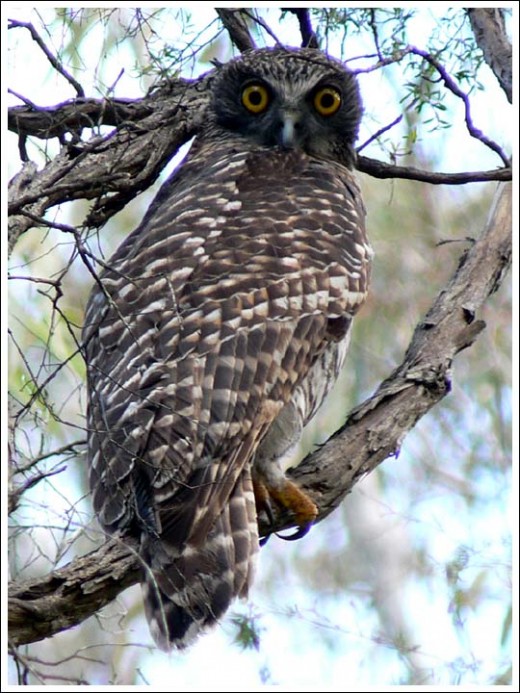 Powerful Owl (Ninox strenua)
(© Photo by Duncan Fraser, ^http://bencruachan.org/blog/?p=170) Powerful Owl (Ninox strenua)
(© Photo by Duncan Fraser, ^http://bencruachan.org/blog/?p=170)
.
The Powerful Owl (Ninox strenua) is Australia’s largest owl, yet in Victoria it has become a threatened species due to human destruction of old growth forest habitat; particularly the destruction of hollow-bearing trees used by this owl for nesting, roosting and home for its natural prey – possums. ‘Powerful Owls are adversely affected by the clearfelling of forests and the consequent conversion of those forests into open landscapes, but the species may persist in forests that have been lightly or selectively logged.’
[Source: ^http://www.birdsaustralia.com.au/our-projects/powerful-owl-wbc.html]
.
Since European settlement, 65% of Victoria’s forest cover has been cleared (Woodgate & Black 1988). Only 5% of freehold land remains forested. This past permanent loss of habitat has likely led to an overall reduction in owl numbers and fragmentation of the original continuous population into a series of small residual populations, each of which is at risk of becoming locally extinct.

‘It is estimated that hollows suitable for owls do not form, even in the fastest-growing eucalypts, until they are at least 150-200 years of age (Parnaby 1995). Of 21 nest trees observed by McNabb (1996) in southern Victoria, about 50% were senescent and all ranged between 350-500 years of age, based on data collected by Ambrose (1982).
Over much of its range, the lack of suitably large hollows is considered to be a limiting factor to successful breeding and population recruitment. The Powerful Owl is, therefore, vulnerable to land management practices that reduce the availability of these tree hollows now or in the future. The loss of hollow-bearing trees has been listed as a potentially threatening process under the Flora and Fauna Guarantee Act (SAC 1991).
In addition, prey density may be an important determinant in territory size and breeding success, particularly considering that only the male hunts during the breeding season. Seebeck (1976) estimated that about 250 possums (or their equivalent) would be required per year by a family group and recent studies have estimated around 300 prey items for a breeding pair rearing two young (Webster unpubl. data.). Key prey are also dependent on hollow trees.’
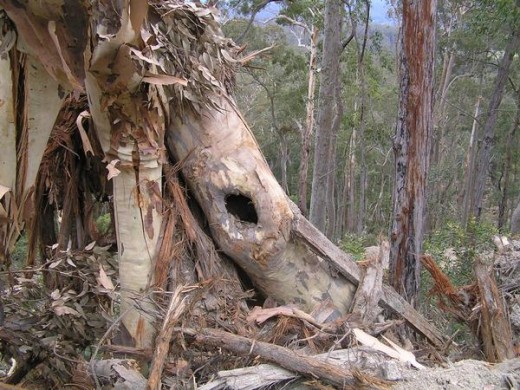
In its final recommendation the Scientific Advisory Committee (SAC 1994) has determined that:
‘the Powerful Owl is significantly prone to future threats which are likely to result in extinction, and very rare in terms of abundance or distribution.’
.
The short-term conservation objective is to prevent further decline by ensuring that good quality habitat for at least a population target of 500 breeding pairs of Powerful Owl is maintained on public land in Victoria.
[Source: ‘Powerful Owl Action Statement‘, Victorian Government’ s Department of Natural Resources and Environment (or whatever its latest incarnation is), ^http://www.oren.org.au/issues/endspp/powerfulowlAS.htm]
.
.
‘Impact of Bushfire on Sooty Owls and Powerful Owls’
[Source: Rohan Bilney, Report on Sooty Owls and Powerful Owls for the Supreme Court proceeding number 8547 of 2009 – Environment East Gippsland v VicForests, pp.12-13]
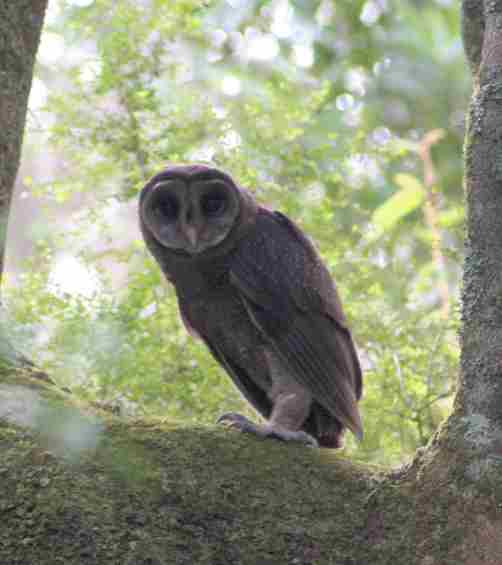
Greater Sooty Owl (Tyto tenebricosa)
.
‘Fire is likely to kill individual owls and small mammals, and remove potential habitat in the short-term, potentially resulting in long-term impacts.
‘How owl populations adapt or respond to fire is largely unknown’
.
‘Fire can consume hollow-bearing trees, while also stimulating hollow formation, but as hollow formation can take decades, frequent fires are likely to result in a net loss of hollow-bearing trees from the landscape (Gibbons and Lindenmayer 2002). This is likely to cause detrimental effects to all hollow-dependant fauna (Catling 1991; Gibbons and Lindenmayer 2002; Garnett et al. 2003).
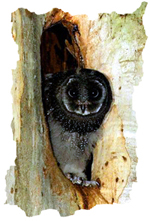
‘Sooty Owls typically occupy habitats subject to infrequent fire regimes such as wetter forest types, possibly due to higher densities of hollow-bearing trees in such landscapes. Frequent fire regimes also simplify habitat structure, which can cause deleterious impacts on terrestrial mammals (Catling 1991; SAC 2001), which includes increased predation rates by feral predators due to the loss of habitat refuge (Wilson and Friend 1999). Overall, it therefore seems likely that owls and small mammals will be negatively impacted by frequent fire regimes. It is likely, however, that it will be the impacts of fire on prey densities that dictate how the owls respond to fire.
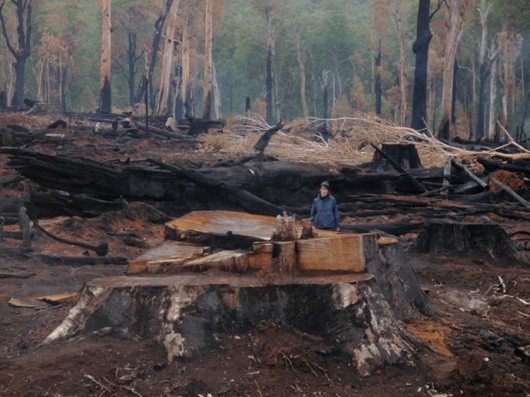 Brown Mountain ancient old growth logged, incinerated, razed by VicForests
(Photo by Environment East Gippsland) Brown Mountain ancient old growth logged, incinerated, razed by VicForests
(Photo by Environment East Gippsland)
.
‘Most species are not adapted to fire per se, but adapted to a particular fire regime, which include fire aspects such as intensity, frequency, seasonality and scale (Bradstock et al. 2002). Due to variations in the life history requirements of species and their ability to survive fire, particular fire regimes can advantage some species, while being deleterious to others (Bradstock et al. 2002; Gill and Catling 2002; Keith et al. 2002). Due to the varying ecological responses to fire, it is important for biodiversity conservation that we not only understand species responses to particular fire regimes, but to ensure that appropriate fire regimes are maintained across the landscape. As prescribed fire is used as a management tool for reducing fuel load to minimise fire risk, it is important that its effects on biodiversity are well understood.
‘Unfortunately, knowledge on how native species respond to particular fire regimes is poorly understood, especially for fauna (SAC 2001, 2003; Clarke 2008). So, in the absence of this crucial ecological information it is virtually impossible to implement appropriate fire regimes which will result in minimal negative ecological impacts, let alone enhance biodiversity. Fire, both prescribed burning and wildfire, can present a threat to owls if conducted at inappropriate seasons, frequency, intensity or scales. It is therefore difficult to quantify the threat. The threat of inappropriate burning at high fire frequencies is likely to be mainly concentrated around human assets and populations, while fires in more remote forested areas will be subject to less frequent fires (DSE 2004). Fire also affects the entire owl population because all habitats occupied by owls is flammable.
‘Victoria has experienced three catastrophic fire events in the past 7 years, and combined with prescribed burning, approximately three million hectares have been burnt in this time.‘
‘This equates to approximately 2/3 of potential Sooty Owl habitat in Victoria. How populations of Sooty Owls and many other forest dependant fauna have been affected by these fires remains poorly understood or unknown. The ability for forest fauna to recover is therefore being hampered by further prescribed burning, and recovery is also hampered by reduced fecundity caused by a decade of drought, and for the owls, low prey population densities.’
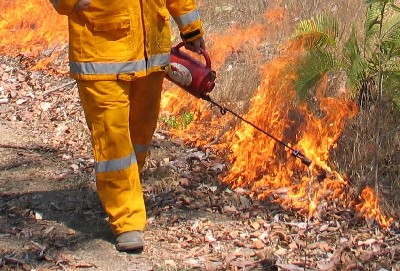
.
.
The ‘Bushfire Fighting Principle’ corrupted by blinkered economic rationalism
.
The traditional principle of bushfire management is to put out bushfires…one would think. Yet this simple concept has been hijacked, bastardised and corrupted by successive governments as a consequence of systemic under-resourcing. Government under-resourcing has contributed to the deadly human toll in recent years.
The corrupting of this core bushfire management principle has morphed into a blanket one-size-fits-all defeatist policy of broadscale prescribed burning – burning the bush before it burns. The bushfire management tradition of ‘suppression‘ has been economically rationalised and politically supplanted by the proactively sounding notion of ‘prevention‘.
In Victoria, the fundamental job of putting out bushfires has bureaucratically morphed into a ‘Code of Practice for Fire Management on Public Land’, with its two general principles…
.Fire management planning on public land must address the threat of wildfire, guide the use of prescribed burning, and provide for the achievement of integrated land management objectives such as human safety and environmental management.’ (Clause 50)
‘Fire management activities must be undertaken in a participative manner where the responsibility for reducing the likelihood and consequence of wildfire is appropriately shared between public and private land holders and managers.’ (Clause 51)
.
What happened to the fundamental principle of bush fire fighting?
To put out bushfires!
Instead, vast areas of remaining native bushland and forests across Australia are being deliberately burnt to the point where critical faunal habitat is sterilised – only the trees remain, while the rich underlying vegetation, demonised as ‘hazardous fuel‘ is incinerated and repeatedly prevented from regrowth. Wildlife habitat has become a fuel hazard targeted for burning by the very custodians charged with wildlife conservation. And out of the Victorian Royal Commission into the Black Saturday bushfires, the anticipated kneejerk response by bushfire agencies to commence Prescribed Burning Armageddon against the bush has started as many genuine conservationists have feared.
And what has been the full realised cost of the 2009 Victorian Bushfires – valuing human lives, human injuries, ongoing trauma, livelihoods, wildlives, livestock, private property, natural assets, on top of the direct operational response cost, the indirect costs of contribiting agencies, the donations raised, capital costs, the opportunity costs, the investigation costs, the Royal Commission costs? No one has come up with a figure. These values were outside the Victorian Royal Commission’s terms of reference – so what real value was it? Economic rationalising of emergency management is costing lives and contributing to species extinctions.
.
.
Victorian Government Policy of Bushfire Lighting
.
The Victorian Government’s delegated custodian on natural areas across the State is the infamous Department of Sustainability and Environment (DSE), with a reputation for lighting most of the bushfires it euphemistically labels as ‘prescribed burning’ wherein it finds unburnt bushland and prescribes its own burning regimes. When such custodial agencies restore the word ‘conservation‘ back into their title, some respect may return.
DSE’s ‘Code of Practice for Fire Management on Public Land‘ was revised in 2006. It relies upon background premises that since “much of the Australian continent is fire-prone”, that “fire occurs naturally”, that “many species of vegetation and wildlife have adapted to living within the natural fire regime” and that “Victoria’s Indigenous people used fire as a land management tool for thousands of years”. The Code justifies that “Victoria’s flora, fauna and the ecosystems they form are adapted to fire of varying frequencies, intensities and seasonality.” Victoria’s Flora and Fauna Guarantee Act 1988 has objectives to ensure “Victoria’s native flora and fauna can survive, flourish, and retain their potential for evolutionary development”. Now the integrity of this Act is under threat. Perversely DSE’s Code of Practice argues that deliberate burning of bushland and forest habitat will help Victoria’s native flora and fauna to survive, flourish, and retain their potential for evolutionary development.
Crap!
DSE stretches its rationalising propaganda further, claiming that excluding bushfire can have “negative consequences for Victoria’s flora and fauna“. And this is where the hijacking, bastardisation and corrupting turns from mythology into unsubstantiated falsehood and misinformation. No document exists to zoologically prove that native fauna will suffer such negative consequences if it does not have a bushfire range through its habitat. As a result, the Code of Practice implies that bushfire is ok for all Victorian bushland and forests – DSE conveniently convinces itself that the urgent moral imperative for DSE to suppress bushfires is extinguished. So now it lights more fires than it puts out.
The Code also premises that “often these wildfires can be difficult to suppress”. Well no wonder with an grossly under-resourced, firetruck-centric volunteer force.
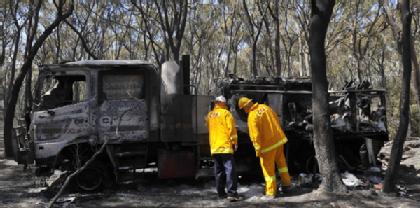 . .
.
‘DSE holds fire management workshop in Bendigo’
.
On 22nd June 2011, DSE staged a workshop of stakeholders to discuss some recommendations of the Royal Commission into Victoria’s February 20o9 bushfire tragedy. According to the website ‘Friends of Box-Ironbark Forests’, in attendance were representatives from the CFA, local government, The Wilderness Society, Bendigo Field Naturalists Club, Friends of Kalimna Park, North Central Victoria Combined Environment Groups [NCVCEG], Apiarists Association and DSE attended a workshop on June 10 to learn about the process for implementing the findings of the Victorian Bushfires Royal Commission. Though Friends of Box-Ironbark Forests (FOBIF) was not invited to this workshop, we were represented by members of some of the other groups.
Once again DSE’s Code of Practice for Fire Management on Public Land (COP) is to again be reviewed and updated, except its premises have not changed, so what’s the point? The following notes taken on the issue of Fire management Zones/Prescriptions is telling of how disconnected DSE is from wildlife habitat conservation:
.
‘Fire Management Zones (FMZ) have been reviewed recently. An interim zoning is to be released soon. With little time left the group briefly discussed the merits of fire management zones, and how they might relate to the risk model. It was highlighted that the residual fuel load is an important aspect, but further detail as to how was not provided.
NCVCEG made the point that the current diagram used by DSE to represent the relationship between ecological outcomes and fire management outcomes across the four FMZ is misleading, encourages poor planning, discourages biodiversity management in zones 1 and 2, and neglects to recognise that fire management outcomes may be achieved in all zones, especially where integrated planning and alternative practices (to prescribed burning) are established.
In relation to FMZ the Apiarists pointed out that Box Ironbark forests generally have very low fuel levels in comparison to heavily forested regions where many lives were lost during the fires in 2009. The merit of burning areas used for honey production was questioned and the long term impacts of severe burning on Box Ironbark forest ecology was raised.’
.
[Source: Friends of Box-Ironbark Forests, 20110622, ^http://www.fobif.org.au/2011/06/dse-holds-fire-management-workshop-in-bendigo/]
.
.
Yet at the same time DSE points out that… ‘biodiversity is in decline‘
.
In its ‘Victoria’s Biodiversity Strategy 2010–2015: Consultation Draft‘ DSE reminds us that two hundred years of (immigrant deforestation), severe droughts, major bushfires and the impact of climate change, has severely affected Victoria’s species and ecosystems. DSE professes:
- Victoria is the most cleared and densely populated state in Australia. Victoria has the highest proportion (48%) of sub-bioregions in Australia in poor condition, with four out of Australia’s five most cleared bioregions found in western Victoria (CES 2008).
- Approximately half of Victoria’s native vegetation has been cleared for agricultural and urban development, including 80% of the original cover on private land. Victoria is losing native vegetation at a rate of some 4,000 hectares per year, mostly from endangered grasslands (DSE 2008).
- Victorian landscapes are the most stressed in the country (NLWRA 2001). One third of Victoria’s major streams are in poor or very poor condition. Two thirds of wetlands have been either lost or degraded and nearly half of our major estuaries are significantly modified. Flows at the Murray mouth are estimated to be a quarter of what would naturally occur (VCMC 2007).
- 44% of our native plants and more than 30% of our animals are either extinct or threatened (CSIRO 2004). The highest number of threatened species in any one region in Australia occurs in north western Victoria.
- Exotic species represent about 30% of the Victorian flora with 1,282 species considered naturalised and a further 214 species considered incipiently naturalised in Victoria. This has increased from 878 naturalised species in 1984. It is estimated that an average of 7.3 new plant species establish in Victoria per year, and this number is increasing by a rate of 0.25 plants per year. Approximately 90% of the native vegetation in Melbourne is impacted by weeds, with more than 50% considered severely degraded. There are 584 serious or potentially serious environmental weeds in Victoria with 129 very serious (CES 2008).
- Over 100 marine species have been introduced to Port Phillip Bay.’
.
[Source: Victorian Government’s Department of Sustainability and Environment, ^http://www.dse.vic.gov.au/conservation-and-environment/biodiversity/victorias-biodiversity-strategy/biodiversity-strategy-renewal/draft-victorian-biodiversity-strategy-2010-2015/current-state, Clause 2.2 ‘Biodiversity is in decline‘]
.
.
State aware but doesn’t care
.
The Victorian landscape has undergone massive changes in the past 150 years. As a consequence of environmental degredation and destruction of indigenous flora and fauna:
- Over 60% of the state has been cleared, and much of what is left is seriously degraded by weed invasion;
- Of the two thirds of the state which is privately owned, only 5% retains its natural cover;
- Soil erosion and salination have become serious problems;
- Over 35% of our wetlands have been drained;
- Close to 80% of rivers and wetlands have been substantially modified;
- Almost all native grasslands have been eliminated or modified;
- Many other vegetation communities are almost extinct, or critically endangered;
- Over 900 exotic plant species have been established in Victoria, many of which are weeds, and scores of noxious exotic animal species are now widespread;
- 23 native mammal species have become extinct in Victoria.
.
[Source: The Southern Peninsula Indigenous Flora & Fauna Association Inc., ^ http://www.spiffa.org/victorias-biodiversity-crisis.html]
.
And the Victorian Government is well aware.
DSE acknowledges that the ‘clearing of native vegetation (across Victoria) and habitat has also led to the loss or decline in wildlife species. Habitat fragmentation has meant that wildlife are more at risk from predators, harsh environmental conditions, and human influences (e.g. roads) as they move between remnant patches. Isolated patches support fewer and lower densities of wildlife, increasing the chances of population extinction in individual patches as a result of the impacts of chance events upon genetically simplified populations. Habitat loss and degradation also increases the susceptibility of wildlife to severe environmental conditions, such as fire and drought, and broader processes, such as climate change and changing rainfall patterns.’
DSE acknowledges that ‘while maintaining or restoring ecosystem function will help to reduce the rate at which species decline, we already have a legacy of species that are at risk due to past ecological disruption, and a latent ‘extinction debt’. Victoria’s past land management actions have resulted in the loss of species and created and ongoing risk of future losses. Many existing threatened species occur in remnant or fragmented landscapes where the work required to recover them is intensive, expensive and long-term. In extreme cases it is necessary to remove part of the remnant population to captivity until critical threats have been mitigated.
DSE acknowledges that ‘effective threatened species recovery requires:
- Effectively dealing with threats to reduce the rate at which species become threatened;
- Conducting recovery efforts in situ by managing the processes that degrade their habitat or directly threaten them, including, where required, support from ex situ conservation programs;
- The best available knowledge and an adaptive management approach, including adoption of the precautionary principle when required;
- Co-operative approaches to recovery, with an effective and efficient mix of incentives and regulations; and
- Planning and regulatory frameworks to provide clear and consistent policy, process and outcomes.’
.
Yet in the same breath DSE goes on to reinforce its ‘fire is good for wildlife‘ propaganda – ‘a substantial proportion of Australia’s unique biota is dependent, to varying degrees, on fire and the variety of fire regimes for its continued existence and development.‘
[Source: DSE’s ‘Code of Practice for Fire Management on Public Land‘, Clause 2.3.8 ‘Challenges relating to fire management’]
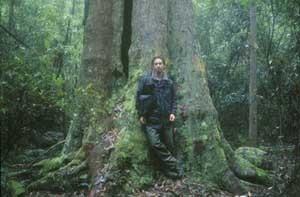
.
.
‘Fuel reduction burns threaten species’ – or Black Saturday incompetence an excuse for broadscale State Arson
[Source: Peter Vaughan, Monash University, Melbourne, 20100531,^http://www.reportage-enviro.com/2010/05/fuel-reduction-burns-threaten-endangered-species/]
.
‘Conservationists are concerned that fuel reduction burns in East Gippsland will threaten endangered species and reduce biodiversity.
On March 16, fire managers from the Department of Sustainability and Environment (DSE) ignited a fuel reduction burn in the Dinner Creek catchment of Waygara state forest, approximately 14 km West of Orbost. The fire quickly gained intensity, aided by a temperature of 30 degrees Celsius. It burnt most of the environmentally sensitive vegetation within the fire zone along four kilometres of the Dinner Creek.
DSE Fire Manager for the Orbost Region, Steve de Voogd, said that the Dinner Creek fuel reduction burn grew hotter than intended. The fire was meant to burn 2206 hectare of coastal forest and leave a mosaic of burnt and un-burnt areas within the fire’s containment lines.
.
According to Mr de Voogd, the DSE is now under community pressure to reduce the risk of wildfire through fuel reduction burning, and that must take precedent over ecological considerations.
.
“Although there is probably room for more fire ecology planning, it is incumbent on the DSE to take action because the consequences of doing nothing may be worse,” Mr de Voogd said.
Most of the hollow bearing trees in the burn zone, which were home to a number of endangered species protected under state and federal law, were destroyed.
Dr Rohan Bilney, an expert on Australian forest owls and spokesperson for the Gippsland Environment Group, said that the program intended to burn large areas of coastal forest without adequate ecological planning, monitoring or research, which threatened crucial habitat and food sources for the forest’s owls species.
.
“The coastal forests of East Gippsland are the strong hold of the Masked Owl, a species listed as threatened under two laws: the Victorian Flora and Fauna Guarantee Act and the Federal Environmental Protection and Biodiversity Conservation Act. Most of East Gippsland’s Masked Owls live in the coastal forests now being subjected to intense broad area fuel reduction burns by the DSE,” said Dr Bilney.
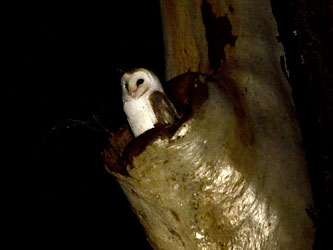
Masked Owl (Tyto novaehollandiae)
.
The Masked Owl Action Statement, prepared under the Victorian Flora and Fauna Guarantee Act, estimates only 150 pairs of Masked Owl exist in Victoria. Of that total, 100 pairs are found in East Gippsland and most are concentrated in the coastal forest.
DSE Manager of Biodiversity in East Gippsland, Dr Steve Henry, said that the current DSE fuel reduction fire strategy allows for large fires but burning on such a scale leaves few options for the protection of important ecological values.
“If there are some areas that contain specific environmental attributes that we want to protect, we could exclude them from fire with a bulldozer line. However that is expensive and often very destructive on most of these large burns. The main management technique used is the way in which the lighting pattern of the fire is done, sometimes that is not as effective as we would hope,” he said.
Mr Henry said that funding constraints have not permitted the DSE to conduct detailed ecological studies of the coastal forests, including the effect of fire on the environment.
A post-fire ecological survey is currently being conducted by the DSE in selected fuel reduction areas.
The Dinner Creek fire was just one of 48 fuel reduction burns planned by the DSE for the region during 2009-2010. Like other fuel reduction burns, the DSE must comply with the Victorian Code of Practice for Fire Management on Public Land.
The primary objective of the Code is to protect of life and property, while minimising negative impacts on natural and cultural values, and abiding by threatened species legislation, are also included.
The Code of Practice also states that the DSE must prepare a Fire Ecology Strategy that includes input from ecological experts and full consideration of all available scientific research.
If little ecological research exists, fuel reduction burning can be conducted under the rational that it may reduce the future risk of wildfire.
.
In the absence of scientific data, the DSE will continue to plan fuel reduction burns from computer desktops, utilising the ad hoc data collected as part of the Environmental Vegetation Class mapping projects of the late 1990s.
While political pressure continues to increase, the DSE fire policy will remain focused on protecting the community against the spectre of Black Saturday.’
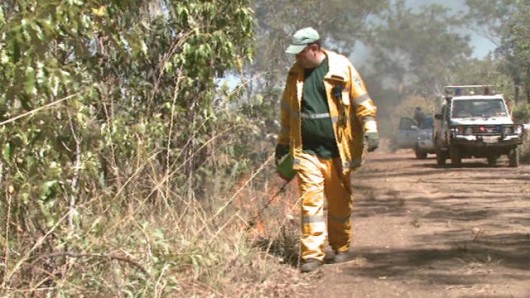 Burn it in case it burns, because we don’t have the resources for wildfire suppression Burn it in case it burns, because we don’t have the resources for wildfire suppression
.
.
‘Climate change, fires and logging -the deadly combination for Victoria’s species’
[Source: Environment East Gippsland, ^http://www.eastgippsland.net.au/?q=node/446]
.
‘Two hundred years ago the Sooty owl was abundant and fed on about 18 species of ground prey in Gippsland. Today they have only two or three to chose from. Other species are under similar pressure.
Many of our native animals have become sparser in numbers and their range has shrunk. Some, like the Southern Brown Bandicoot (Federally listed but not State listed), are now isolated in small “island” populations which are dangerously close to extinction mainly due to threats of fire and predation. Fires destroy understorey cover, making it easy for foxes and dogs to wipe out small populations of ground dwelling animals.
The 2003 fires and the recent December ’06 fires have destroyed the habitat and ground cover over about 2 million hectares of Victoria’s forested country. This has had a horrifying impact on ground mammals, birds and hollow dependent species.
.
Scientist and Quoll expert, Dr Chris Belcher, has calculated that this species’ Victorian numbers were reduced by 33 – 45% as a result of the ’03 fires. The December ’06 fires would have reduced this again to even more precarious numbers.
The isolated colony of Long Footed Potoroos discovered around Wonangatta (or Wongongara?) will most likely have been killed as a result of the recent fires.
The Helmeted Honeyeaters had five small and isolated populations left but the 1983 fires wiped out four of them. Yellingbo is still likely to burn and our faunal emblem will be extinct on this planet.
Bandicoots are very fire sensitive. There are small and vulnerable populations scattered in Gippsland. In 1994, fires burnt 97% of the Royal National Park and Bandicoots no longer survive in this area. The safety of thick ground cover does not return for years, meaning foxes and dogs heavily predate any survivors.
.
East Gippsland is the last stronghold for many of our rare and endangered fauna. It is a wetter environment and has much higher floristic diversity and therefore animals.
Climate change will now make fires more frequent and intense in SE Australia (CSIRO). Governments must adapt management of natural areas to account for this reality as it is for agriculture, water and energy.
The greatest pressure on Eastern Victorian species has been in the Critical Weight Range from 35 gms to 5 kg. Many ground dwelling animals are extremely susceptible to fire. Potoroos, Quolls, Bandicoots, native rodents (the rare New Holland Mouse, Smokey Mouse etc).
The predation rate after a fire is huge and patches of unburnt forest within the fire zones are absolutely essential to help populations survive predation, recover and disperse in time. These areas are critical to protect from further disturbance.
The recovery of species after a fire is now very different from 200 yrs ago. Populations are more isolated, salvage logging further destroys their chances, there is less diversity of prey species for the higher order predators like owls and quolls to turn to if gliders and possums are impacted by fires (or logging the hollow-rich forests).
Logging ecologically diverse forests favours the return of biologically poor tree communities such as silvertop and stringybark. The forests with mixed gum and box throughout can have 20-50 times higher animal densities. Significant vegetation changes due to massive landscape disturbance such as clearfelling, makes endangered species recovery from fire even more unlikely.
In the 1990s, East Gippsland supported seven times more threatened species than other areas in Victoria. This made the region seven times more important for our endangered species’ survival. Since the fires of 03 and 06, it is not unreasonable to suggest that East Gippsland is the last refuge and last chance for these species to survive extinction. Extinction can happen very quickly.
Species which are fairly general in their roosting, nesting and feeding needs can often survive (as they have in other areas of the state) but the many specialist species which rely on large areas of diverse and thick forest are highly likely to vanish forever.
This is why the hasty and unscientifically mapped areas of newly reserved forest require careful refinements. The needs of the state’s threatened species must be made the priority. Independent biologists and on-ground local knowledge (not VicForests) must be used to finalise the new reserve boundaries, with the long-term impact of the recent fires as a major guiding factor.
The Bracks Government suggested there be no net loss of resource as an adjunct to the mapped reserve areas. This is an impossible and irrational qualification as fires can take out large percent of the forest and therefore wood resources in one season. Commercial use of forest should be allocated only after biologically essential considerations have been adequately addressed.
Another point made in pre-election promises was to make sure the new areas are mapped and industry changes are resourced so as to adhere to the terms and spirit of the RFA. This then should see the government honour its long overdue commitment to carry out research into the impact of clearfelling on threatened species, to identify sustainability indicators, carry out five yearly reviews and ensure threatened species are protected. None have been honoured in the last 10 years!
The recent court ruling regarding the EPBC Act should also give the state government substantial opportunity to begin to alter protection measures for Federally listed species in East Gippsland.
The conscience of this government cannot put the very limited future of several sawmills ahead of a large number of entire species. Continued logging of intact original forests must not be the overriding priority. The ability for species to cope with the escalating impacts of climate change and fires from 2007 onwards has to now be put ahead of politics and union threats. These species survived well in Australia for over 40,000 years. The clearfell logging industry has been around for less than 40 years. Political priorities have an even shorter lifespan.’
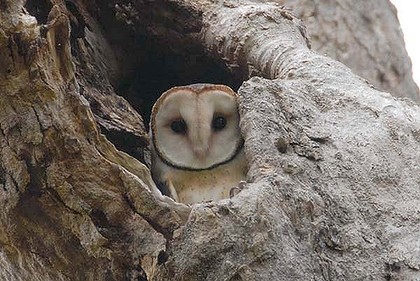
.
.
Further Reading:
.
[1] ^ http://eastgippsland.net.au/files/Sooty_Owl_%20Powerful_Owl_Bilney_December_2009.pdf , [ Read Report]
[2] Environment East Gippsland website, ^ http://www.eastgippsland.net.au/
[3] ‘ Sooty Owl Action Statement‘, Victorian Department of Sustainability and Environment (DSE), [ Read Statement]
[4] ‘ Powerful Owl Action Statement‘, (DSE) ^ http://www.dse.vic.gov.au/__data/assets/pdf_file/0019/103177/092_powerful_owl_1999.pdf , [ Read Statement]
[5] ‘ Masked Owl Action Statement‘, (DSE), ^ http://www.dse.vic.gov.au/__data/assets/pdf_file/0015/103173/124_Masked_Owl_2001.pdf , [Read Statement]
[6] Victorian Rainforest Network website, ^ http://www.vicrainforest.org/
[7] The Southern Peninsula Indigenous Flora & Fauna Association Inc., ^ http://www.spiffa.org/victorias-biodiversity-crisis.html
[8] ‘Protecting Victoria’s Powerful Owls’, ^ http://www.dse.vic.gov.au/__data/assets/pdf_file/0012/102144/PowerfulOwls.pdf , [ Read Report]
[9] ‘ Fire Protection Plan Gippsland Region‘, 2011, ^ http://www.dse.vic.gov.au/fire-and-other-emergencies/fire-management/fire-protection-plans/fire-protection-plan-gippsland-region , [ Read Plan]
[10] ‘ North East Victoria: Biodiversity‘, Australian Department of Agriculture, Fisheries and Forestry, ^http://www.daff.gov.au/__data/assets/pdf_file/0007/63583/Environmental_Values.pdf , [ Read Report]
[11] ‘ Submission to East Gippsland Forest Management Zone Amendments September 2010‘, ^ http://vnpa.org.au/admin/library/attachments/Submissions/EG%20Zoning%20Review%20Joint%20Submission%20ENGO%20Groups.pdf , [ Read Report]
[12] ‘ Ecology and conservation of owls‘ by Ian Newton, ^ http://www.publish.csiro.au/pid/3152.htm
.
Tags: DSE, Flora and Fauna Guarantee Act, fuel reduction program, habitat trees, hazard reduction, hollow trees, hollow-dependant fauna, Masked Owl, Powerful Owl, prescribed burning, Sooty Owl, State Arson, State Logging, VicForests, Victoria's old growth forests, Victorian Bushfires Royal Commission, Victorian Department of Sustainability and Environment
Posted in Gippsland (AU), Owls, Threats from Bushfire, Threats from Deforestation | No Comments »
Add this post to Del.icio.us - Digg
Sunday, August 7th, 2011
The following article was initially posted Tigerquoll on CanDoBetter.net 20090422, and subsequently updated.
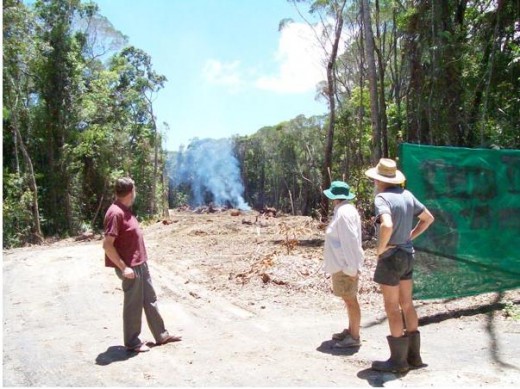 Logging a road through old-growth rainforest
Atherton Tablelands, Far North Queensland
© 2008 Friends of the Earth Kuranda
[Source http://foekuranda.org/]
Logging a road through old-growth rainforest
Atherton Tablelands, Far North Queensland
© 2008 Friends of the Earth Kuranda
[Source http://foekuranda.org/]
.
‘World Forestry Day’ on 21st March is a greenwash promotion by the logging industry. It has the same meaning as the oxymoronic ‘eco-logging‘ (see above photograph).
[‘Eco=logging‘ means that we do leave some trees, sometimes. Some dodgy entrepreneur in South America has tried to register the name ‘ecologging’ as a trademark [^Read More] ]
The concept sounds noble enough on the Victorian Government’s Department of Sustainability and Environment (DSE) site:
“World Forestry Day has been celebrated around the world for 30 years to remind communities of the importance of forests and the many benefits which we gain from them. The concept of having a World Forestry Day originated at the 23rd General Assembly of the European Confederation of Agriculture in 1971.”
.
But hang on a second!
…a “Confederation of Agriculture” …this suggests a different set of values than anecological respect for native forests; somewhat more to do with agriculture (aka ‘logging‘). But I let the Victorian Government’s Dept of Sustainability and Environment (DSE) site continue:
.
“Forests provide many valuable things for the whole community. These include fresh water from forested catchments, a safe home for our flora and fauna, timber for our homes, furniture and paper, beautiful scenery and rugged environments for those who enjoy the outdoors, pollen and nectar for honey production, and archaeological and historical sites.”
“Today, Victoria has an area of approximately 22.7 million hectares. About 40% is public land, meaning that it is owned by the State and managed by the government. There are about 4.8 million hectares of publicly owned native forest which is divided into the following categories: National parks and reserves – 1.7 million hectares, State forest – 3.1 million hectares.”
“Less than one third of Victoria’s state forests are available for timber harvesting and these forests produce more than two million cubic metres of wood products which return about $50 million in revenue to the State.”
.
Ah Ha! So it’s all about revenue FROM our native forests, not a about being FOR our native forests! That phrase ‘timber harvesting‘ conveys such wholesome overtones of good honest pastoral labour, except it’s bloody logging forests! The term has been borrowed by poachers slaughtering kangaroos who euphemistically label the wildlife crime as ‘kangaroo harvesting‘.
So why not just rename this green-washing ‘World Forestry Day‘ what it really is: a celebration of logging – and rename it ‘World Logging Day‘?
DSE on its site suggests:
‘What can I do on World Forestry Day?” ..well children (the propaganda targets school children):
“Celebrate World Forestry Day by visiting your local forests and learning more about the many contributions they make to our well-being. For further information and ideas, see our Forest Education Information.” This link then takes the children directly to the ‘For Schools;’ section of its website which sends a key mesage [sic] to students that ‘forests have many different uses and values.” A second link takes children direct to the hardcore logging site of the Department of Primary Industries”.
[SOURCE: ^http://www.dse.vic.gov.au/DSE/nrenfor.nsf/childdocs/-8E773CD126CA22704A256AA40000EDEE-034EBCC6B1670D984A256AA40011A9F8?open]
.
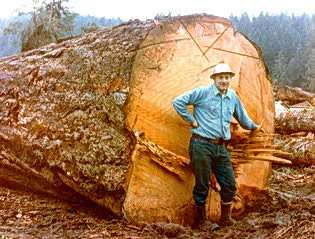 Proud logger Proud logger
.
Forests should be celebrated in their natural state, not by their exploitative revenue potential. Pity that we are now celebrating these in islands and outside the mainstream media. The contrasting ‘Earth Hour’ hype of late seems so token, yet attracts such mainstream publicity and has even Peter Garrett as its cheerleader! But beyond people thinking about turning off lights, Earth Hour pales in addressing irreversible planet damage compared with any day that recognizes the value of global forests.
Recognising natural undisturbed forests and the ‘green carbon’ benefits they contribute to a healthy global future is more important than token politics. As advocated by Professor Brendan Mackey in an article in EEG’s The Potoroo Review (current Spring/Summer 2008-09 edition, p9), “estimates that around 9.3 billion tones of carbon can be stored in the 14.5 million hectares of eucalypt forest in southeast Australia IF THEY ARE LEFT UNDISTURBED.”
While one supports the celebration of native forests in their natural place, the drawback of World Forestry Day is that the forestry industry has corrupted the word ‘forestry’ into a vernacular meaning of ‘exploitation value’.
.
.
World Forest Day – online propaganda during 2010
.
In 2010, if one searched ‘World Forestry Day’ online, one got the following suspicious results:
.
Google Search #1: Department of Sustainability and Environment (DSE) (aka Victorian Government)…say no more
http://www.dse.vic.gov.au/DSE/nrenfor.nsf/childdocs/-8E773CD126CA227 04A256AA40000EDE E-034EBCC6B1670D 984A256AA40011A9 F8?open
.
Search Result in 2011: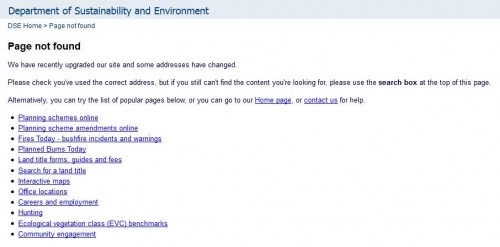
.
Google Search #2: NSW Department of Primary Industries | Forests (a chainsaw endorsed site)
http://www.forest.nsw.gov.au/publication/forest_facts/celebrating_ trees_forests/default.asp
.
Search Result in 2011: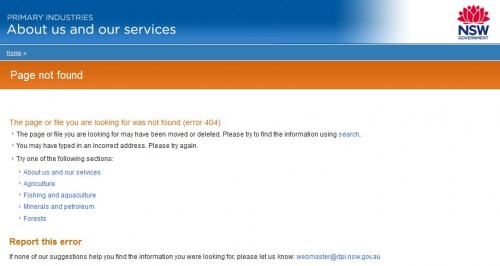
.
Google Search #3: Global Education, but linked to ‘DSE’ after scrolling down the page
http://www.forest.nsw.gov.au/publication/forest_facts/celebrating_ trees_forests/default.asp4: Better Health Victoria
(another Victorian Government website)
.
Search Result in 2011: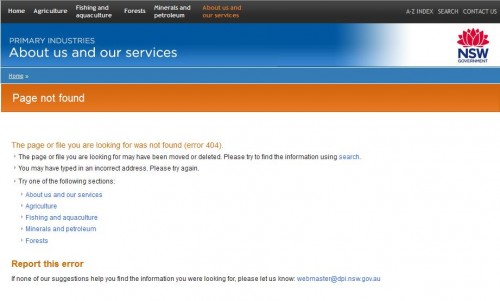
.
Google Search #4: Better Health (Victorian Government again)
http://www.betterhealth.vic.gov.au/bhcv2/bhcevent.nsf/pages/DF43C04B6CC6D19E CA257250007C8F46 ?opendocument
.
Search Result in 2011:
.
So when searching ‘World Forestry Day‘ online, clearly Australian state governments’ greenwashing has set up prime presence.
[Editor: The above government links have disappeared consistent with government short-termism].
.
.
NAFI Propaganda
.
Equally the National Association of Forestry Industries (NAFI) ^http://www.nafi.com.au offered a propaganda page on World Forest Day during 2011.
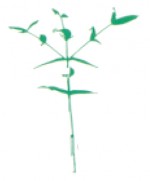 NAFI’s logo
NAFI’s logo
.
NAFI boasts that it is..
‘the peak forest industry body in Australia representing a wide variety of companies involved in forest management, wood processing, commercial tree plantation growing, timber sales and distribution, carbon offset growers, forestry harvesters, haulage contractors, and engineered wood products manufacturers. NAFI also represents the interests of forestry research bodies, timber community groups and state forest industry bodies.’
.
Not surprisingly NAFI is located within a ten minute drive of Parliament House Canberra, with a politician never out of earshot.
.
NAFI’s VISION THING
.
‘The vision of NAFI is for an ecologicaly [sic] sustainable Australian society based, in part, on a dynamic, internationally competitive forest industry.’
Clearly drafted by an expensive consultant, it is utopian in its desire for harmonious co-existence between making a buck from logging forests, and conserving the ecological values of those same forests. In other words having one’s cake and eating it too. Pity they couldn’t spell ‘ecologically’.
Yet, conspicuously, ‘ecologically sustainable’ is missing in NAFI’s Objectives.
.
NAFI’s OBJECTIVES
.
- Improve the commercial results and investment attractiveness of the forest industries through favourable government policy decision and actions (i.e. make money from logging).
- Create a preferred position for the Australian forest industries in the rapidly changing international framework of treaties, codes of practice, standards, conventions and legislation. (i.e. influence law making so that more money can be made from logging).
- Achieve widespread community recognition of the social, environmental and economic benefits of forest industries. (i.e. drive a propaganda strategy to win hearts and minds that logging is good).
- Support and promote innovation, research and development. (i.e. pay universities to write reports to show that logging is good).
- Improve market opportunities and competitive advantage in order to increase demand for forest products and achieve consumer satisfaction (i.e. market logging).
- Achieve maximum utilisation of Australian resources within a framework of an open and competitive market. (i.e. be efficient by logging all the forest and invite others to join in).
- Service members needs and maximise industry ownership and involvement in the Association. (i.e. lobby loggers interests for more forests to log and build numbers to maximise political influence)
.
Without compromise, the above objectives convey a single minded focus on commercial logging of forests.
.
NAFI’s BIGGER LOGGER LOBBY GROUPING: ‘AFPA’
.
Consistent with the NAFI objectives (not the VISION), in April 2011 the Australian Forest Products Association (AFPA) was formed through the merger of the Australian Plantations Products and Paper Industry Council (A3P) and the National Association of Forest Industries (NAFI). Nothing uncertain about the motives of this organisation. Anyone who profits from logging is represented by AFPA – ‘tree plantation growers, harvest and haulage contractors, sawmillers, forest product exporters, and pulp and paper processors’. The new website is ^http://www.ausfpa.com.au/site/
Not surprisingly, AFPA is strategically located in NAFI’s offices, just a ten minute drive from Parliament House, Canberra, with ready access to the hearts and minds of Australia’s federal politicians.
A few weeks prior on 21 March 2011, a gala dinner was staged between the loggers and the politicians up the road at Parliament House, Canberra to (believe it or not) celebrate the United Nations’ Declaration of 2011 as the ‘International Year of Forests’. The logger body’s response to 2011 being the ‘International Year of Forests’ has been to unite loggers into a single united mighty lobbying force for logging – the AFPA.
“A single voice, a single association, is a clearer and more concise way to present the forest products industry to governments, the media and the people of Australia in a united fashion.”
– Linda Sewell, transitional Chairperson of AFPA and A3P Chairperson, after announcing the creation of AFPA in Canberra on 21 March 2011.
No surprise who is on the Transitional Board of AFPA – loggers and logging product merchants one and all:
- Ms Linda Sewell, HVP Plantations (Transitional Chairperson)
- Mr Bryan Tisher, Boral Timbers (Transitional Treasurer)
- Mr Greg McCormack, Midway Ptd Ltd
- Dr Hans Drielsma, Forestry Tasmania
- Mr Ian Telfer, WA Plantation Resources (WAPRES)
- Mr Jim Snelson, Carter Holt Harvey (CHH)
- Mr John McNamara, Hyne & Son
- Dr Jon Ryder, Australian Paper
- Mr Terry Edwards, Forest Industries Association of Tasmania (FIAT)
- Mr Vince Erasmus, Elders Forestry
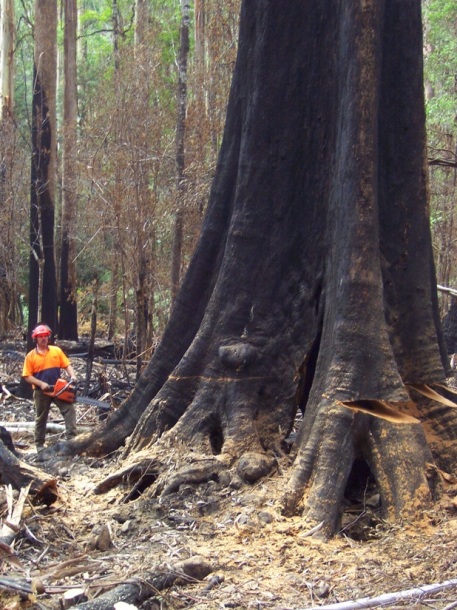 A more apt logo for the Logging Industry A more apt logo for the Logging Industry
The motives for World Forestry Day are nothing but blatant pro-logging propaganda.
  Stihl Chainsawing Old-Growth Stihl Chainsawing Old-Growth
…’are you looking for the best chainsaw for cutting trees?’ ~ quote from Stihl’s website.
.
The term ‘Existence value’ deserves to be further explored and promulgated, so we can develop a greater non-utilitarian value of our natural and now rare forests. Our precious forest exists for their own sake, the forest ecosystems they support and of which we have so little comprehension of their global existence value and scarcity.
– end of article –
Tags: AFPA, Australian Forest Products Association, DSE, eco-logging, forestry, General Assembly of the European Confederation of Agriculture, greenwashing, logging industry, NAFI, National Association of Forestry Industries, Stihl, stihl chainsawing old-growth, Victorian Department of Sustainability and Environment, World Forestry Day, world logging day
Posted in Threats from Deforestation, Threats from Greenwashing, Threats from Road Making | No Comments »
Add this post to Del.icio.us - Digg
Saturday, July 23rd, 2011
 Posted by Tigerquoll: Posted by Tigerquoll:
The VicMolesters are at it again.
Chainsaw-wielding loggers of VicForests are set to target old growth Mountain Ash near Sylvia Creek in the Central Highlands, to Melbourne’s north, east of Kinglake. That an inferno that was Black Saturday in February 2009 ripped through forests in the area around Narbethong, Toolangi and Kinglake matters squat to these woodchip mercenaries.
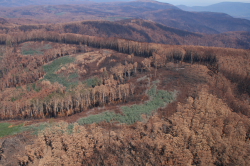 The Burned Area Emergency Response Report (BAER) commissioned by the Brumby Government after the 2009 bushfires recommended preserving refuge areas such as those in Toolangi for biodiversity recovery. The Burned Area Emergency Response Report (BAER) commissioned by the Brumby Government after the 2009 bushfires recommended preserving refuge areas such as those in Toolangi for biodiversity recovery.
That the targeted forests have become isolated islands of habitat to rare wildlife matters squat to them. That the forests are home to Victoria’s endangered and disappearing Leadbeater’s possum, the Spotted-Tail Quoll, the Sooty Owl, and Baw Baw frog are but collateral damage to these bastards. “Over half the Leadbeater’s Possum’s forest habitat was destroyed in the Black Saturday bushfires, so every last bit that survives is incredibly precious, and essential to this tiny animals’ survival,” said spokesperson for local group ‘My Environment’ Sarah Rees.

“The criteria the government is using to identify Leadbeater’s Possum habitat are too conservative. We’re talking about Victoria’s wildlife emblem, we should be making sure they multiply and flourish, not simply cling on to the edge of survival.”
VicForests old growth logging is all for a quick buck from woodchip sales to make Reflex Paper. They would sell their daughters for less.
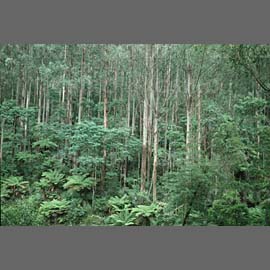
“DSE has confirmed the logging coupe contains old growth trees, even though VicForests and Government Minister Louise Asher insisted last week that it was not old growth forest,” said Wilderness Society forest campaigner Luke Chamberlain.
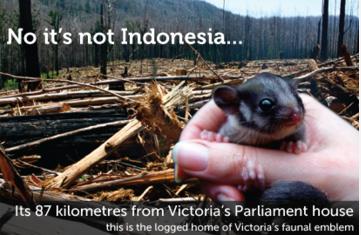
Tigerquoll
Suggan Buggan
Snowy River Region
Victoria 3885
Australia
Tags: Baw Baw Frog, Black Saturday, Burned Area Emergency Response Report, DSE, Eucalyptus regnans, Leadbeaters Possum, old growth granny killers, Sooty Owl, Spotted-Tail Quoll, Sylvia Creek, The Wilderness Society, Toolangi, VicForests, VicMolesters
Posted in Owls, Possums and Gliders, Quolls, Reptiles, Threats from Bushfire, Threats from Deforestation | No Comments »
Add this post to Del.icio.us - Digg
Friday, July 15th, 2011
The following article by Tigerquoll was initially published on CandoBetter.net on 20090312
.
During Victoria’s devastating 2009 bushfires, few will be aware that the Victorian Government’s so-called Department of Sustainability and Environment (DSE) allowed nearly all of the natural ecology of the northern half of Wilsons Promontory National Park (‘The Prom’) to burn at will.
Indeed ‘DSE’ has long been colloquially denigrated by rural Victorians as an acronym for ‘Department of Sparks and Embers‘ for such very reason.

Out of control, lack of resources?, or has The Prom Fire (now having destroyed 24,800 hectares of native habitat) in fact been deliberately left to burn?
DSE in collaboration with the Victorian Government’s CFA (Country Fire Authority) have protected private property at Tidal River and Yanakie.
Perhaps ‘CFA’ has similarly become an acronym for…’Culpable Fire Arsonists‘.
- What really has been going on at The Prom behind the fire barricade out of public view?
- Why was the small fire north of Sealers Cove not extinguished on Friday 13th February 2009, when it was nearly out?
- Why after three weeks with mild weather conditions has this wildfire not been put out?
- Why, ahead of more forecast hot winds, has DSE risked this fire continuing?
…government silence is deafening!
.
Is this really an opportunistic prescribed burn…thanks to lightning? Is it in fact because the DSE doesn’t want the fire out..not until its prescribed burn area is burnt?
A DSE operational fire planning document sourced from the Yarram Fire Distict (which includes The Prom) shows that most of The Prom that has now been burnt is in fact part of DSE’s ‘Planned Burns’ for 2009, 2010 and 2011 anyway. The DSE map (click link below) shows no fires history for the northern half of The Prom.
…’so quick let’s burn it, lest it burns!’
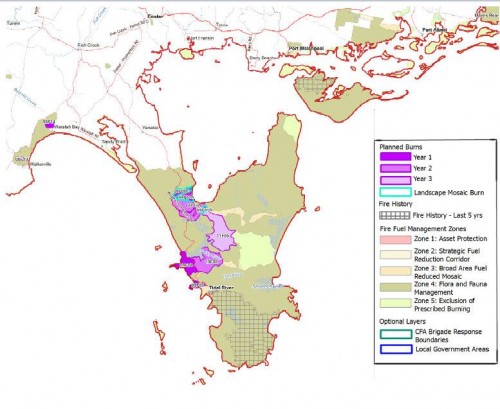 [CLICK MAP TO ENLARGE] [CLICK MAP TO ENLARGE]
Yarram Fire Operations Plan 2008/09 – 2010/11 – showing most of Wilsons Promontory colour coded for planned burning.
© Firemap Tue 14th Oct 2008
.
On this DSE planned burn map of The Prom, no areas are off limits from burning save the few villages and small pockets of private property and what the DSE has mapped as Zone 5 ‘Exclusion of Prescribed Burning’.
All other natural bushland areas of The Prom have been targeted by DSE for burning anyway.
This prescribed burning culture labels all bush hazardous ‘fuel’ and a demonic threat. Instead of putting out the fires in bushland they let the bush burn and all the native animals burn alive in the process.
They brag… ‘we save houses, the bush will grow back so what’s the problem?’
The ‘Department for Sparks and Embers’ is living up to its name.
But who’s responsible for the fauna?

.
.
Comments:
.
Is DSE helping developers get at the Prom??
March 4th, 2009 by ‘Prudence C’:
.
I would go further.
Are the developers that are driving this country to ruin actually after the Prom???
Does DSE, which is removing all rights from citizens to object to development, purposefully causing extinctions through burning so that soon it will be able to say, “Oh, all that land is degraded, it may as well be developed”?
I would put NOTHING past this government.
It should not be allowed to get away with what it has already done to Wilson’s PRom.
DSE is really just an old wood-feller’s hang-out. It should be closed down and something that cares about animals put in its place.
.
.
Vic DSE’s handling of Wilson’s Promontory fire defended
March 22nd, 2009 by ‘callum’:
.
You people have no idea what DSE try to do to get that fire out as so as they could! Where it was burn is very thick bushland and very high country you couldn’t get fire trucks in there. they tried droppin strike teams in but with the water bomber not make making a difference there was no point keep it going to without the water bomber the strike teams weren’t allow to stay on the fire front. so they had to wait until the fire got to where they could attack it. so before you start having a go at dse get the facts right. because the DSE did a great of protecting as much of the prom as they could. if they wanted the whole thing to burn they would have sat at the enterance to the prom and watched it burn! (Abuse removed – JS (Can DoBetter.net editor))
.
.
DSE’s prom effort was opportunistic prescribed burning
March 25th, 2009 by Tigerquoll:
.
Callum (above comment) claims the remote fire on Wilsons Promontory could not be put out.
The evidence is that on 13th March 2009 it was almost out due to rain, according to a timely online NASA satellite photograph. A fire truck approach for remote ignitions is obviously not going to work. It’s a bit like trying to connect up to the nearest fire hydrant in the bush. Such an urban fire fighting approach to remote ignitions is clearly flawed. The fact is that the Victorian government grossly under-resources remote fire fighting. This results in stuff all effective ignition detection (delegated volunteers rely on a goodwilled member of the public to ring 000 before fire trucks roll) and stuff all in effective response and suppression – if the truck hoses can’t reach the remote ignition, let’s sit and wait -it’s only bush. The resourcing of serious standby airborne Canadairs and Aircranes is beyond Brumby’s mindset, the let the bush burn culture is stuffed.
Questions to Callum, assuming he is duly informed about the actual fire response operation:
- Why did the “water bomber” not make making a difference to controlling the fire – especially on or before the 13th, before the wind speed picked up?
- Why were not extra water bombers including dedicated aircranes deployed immediately?
- Why weren’t the strike teams allowed to stay on the fire front and extra strike teams deployed, if necessary from interstate?
- Why did DSE have to wait until the fire got to where they could attack it?
- Why doesn’t DSE have an effective response strategy to remote fires?
(This was one ignition in favourable weaher conditions leading up to the 13th March).
- Was not most of the northern Prom burnt consistent with the 2009-11 fire plan of the Yarram Fire District?
- A lot of Victoria has thick bushland and very high country, moreso than the comparatively accessible (by air) coastal landscape of The Prom.
- How is DSE measured on its performance – by the minimal amount of area burnt due to fast and effective suppression? If so it has failed Victorians and their forests big time.
.
If DSE can be demonstrated to not have used every resource possible to quell this fire, the the presumption of opportunistic prscribed burning remains and the organisation deserves to be disbanded.
What’s the bet that Brumby’s Royal Commission ignores the Prom and the plight of ground dwelling fauna?
.
.
A large number of native
April 14th, 2009 by ‘Anonymous’:
.
A large number of native plant species in the Prom (and indeed, across Victoria) require fire to persist. There are however many species that will not survive fire (including animals obviously). The problem is that the species that require fire to disperse their seeds, sprout from epicormic shoots, flower like the native grass tree and for dormant seeds in the soil to be stimulated by fire do not survive the type of fire that spread through the Prom on the 13th March. Controlled fires are only lit when they can be managed and are either hot quick burns or slow not so hot burns. There are many ecologists that would give you this same view point. If you are correct and the DSE allowed this fire to burn then they should be held accountable but I seriously doubt that this was their conscious decision. They would be fully aware that many species would be lost.
While I understand your arguements, I think that you are being unreasonably harsh. The Prom fires were not immediately endangering property or person, of course the government would deploy all efforts in areas such as Healesville and Marysville where this was the danger before protecting native bushland. I think that this fire season was a unique situation and had there not been immediate danger to human life then I’m sure the management of the Prom fires would have been handled differently.
.
.
Let the DSE publicly justify its actions
April 14th, 2009 by Tigerquoll:
.
The desperately dependent myth that a few native plants require fire to survive is perpetuated to the extent that encourages DSE and CFA to incinerate all Victoria within cooee of a Eucalypt. Latching on to epicorimic growth seems to justfy incinerating ground dwelling mammalian habitat. Since when did a Potoroo sprout epicotic paws? DSE, to have any legitimacy beyond myth must provide independent ecological authority of the mandatory requirement for fire for species survival. I challenge the conspicuously ignored fact that any species of Australian fauna require fire to survive. Try lighting fire to you hand or house and see the reaction!
The bushphobic myth is defeatist! Burn the bush in case it burns!
Isn’t the real problem the fact that rural fire authorities are denied the right resources to instantly detect, respond to and suppress remote ignitions. Relying on calls to 000 and sitting in fire trucks is useless in quelling ignitions in rugged and remote country. It must be immensely frustrating to watch a fire grow into an uncontrollable monster because one is denied by government the right resources to deal with it while it is controllable. The considerable investment needed and asked for from government to fight fires while they are controllable, pale compared to the massive tragedy of letting a wildfire rip lives, property, wildlife and heritage to cinders because of government cost savings.
Then what a cheek to hear government thank the charities for picking up the tab and then to target mass burning of the natural environment just because government does not want to fund State of the Art fire fighting – which would instantly detect, respond to and suppress remote ignitions with military precision – saving lives, property, the rural way of life and our wildlife like genuine heroes.
The wildfire problem is likely to get worse with drought and arsonists more prevalent. Waiting for a remote ignition to reach a control line is what they in the 1940s. The risk and cost is too great to rely on a dad’s army response in the 21st Century, unless you have a mantra to destroy the Aussie landscape and create a neo-colonial parkland.
.
.
Your comments appear only half-educated
July 20th, 2009 by ‘artemis’:
.
No offence, but your comments appear only half-educated. A prescribed burn is done in pockets, so that an entire area is not burned off all at one time. This allows animals to continue to flourish in the wider area. This is what is called a “mosaic” effect. Which is why you see the DSE have burnt a little each year over the last few years. This is not “bush phobic” but takes into account the fact that the Australian bush has a complex and necessary relationship with fire for propagation and the DSE tries to work with the bush to encourage it at its natural state as best as possible without injuring or harming the humans that now inhabit it so profusely. In fact you will find that when prescribed burns as the Aboriginals carried them out stopped, certain species of animals that thrived and lived in the edges of them became extinct.
As fire is the natural state of the Australian bush, you will never stop it, the best we can do in our situation, is learn to harmoniously work with the land and manage it. If you understand it from this angle you will understand that prescribed burns cause no where near the damage to flora, fauna, the environment and humans as the huge deadly wildfires that occur if we don’t prescribe burn.
The DSE and the CFA are both committed to working to save the environment as much as possible, unfortunately too many people see them as the enemy – humans love to have a tangible enemy to attack, even if that means turning on one another when convenient. It will be nice when people finally realize that prescribed burns are much more green than they first understood.
.
.
Prescribed burning is based on unsupported myths
July 21st, 2009 by Tigerquoll:
.
Mosaic prescribed burns immediately around built assets (aka Asset Protection Zones) would seem sustainable. Building approvals only in low bushfire risk areas would seem sustainable. Permitting building construction out of non-combustible and fire retardant material would seem sustainable.
But the ‘bushphobic’ culture has pushed the boundaries and scale well beyond immediate protection of buildings. The scale of bush burning into remote wild parts of Victoria by DSE and the CFA is broadscale and massive and causing local faunal extinctions. Take a look at the DSE site
Take also one small example of a CFA fire district in Victoria. The Yarram Fire District in South Gippsland in its DSE Approved Fire Operations Plan [2008/09 to 2010/11] for 2500 hectares of bush to be deliberately burned.
The issue of burning the bush is indeed complex, yet the ecological complexity and impact is not understood or appreciated by DSE or CFA. How do you know that “DSE activities “allows animals to continue to flourish in the wider area”
Where are your statistics Artemis? Why are not independent zoologists with experts in Australia’s native fauna providing independent public reports supporting each Proposed Plan Burn by the DSE and CFA across Victoria? Too embarrassing, especially when these get out of control 1 in every 2? It is because the DSE and CFA have cumulatively destroyed more native habitat that any other threatened process? Look at Wilsons Promontory in 2009 and 2005! Default prescribed burning from the convenience of lightning. No building threatened so let the bastard – saves us the work anyway on the Fire Plan and we can always argue the old “it was burning in inaccessible country” excuse – works every time, guaranteed!
Controlled limited ‘mosaic’ burning that excludes flora species and ecological systems vulnerable or intolerant to fire is the PR spin. But on the ground prescribed burning is not an exact science. It is not undertaken scientifically nor supervised scientifically or able to be independently verified as compliant. The DSE or CFA have no independent public watchdog. They are a law under themselves and they know it. Weekend warriors end up torching most of the prescribed burns – “this’ll do!” If it gets out of control, we’ll deal with it but actually it will save us bother next time and minimise the fire risk next summer.
The Aboriginal firestick burning is another excuse used to justify deliberate arson of wild landscapes remote from buildings is another old school fire management myth, lacking scientific merit. Since when did ancient Aborigines drop aerial incendiaries over vast inaccessible areas every year?
The Armageddon myth is another bushphobic alarmist excuse to try to justify slashing and burning as much bush as possible ‘before it burns’ every seven years or so. This way no bush is ever allowed to live beyond seven years. The main reason huge deadly wildfires occur is because the fire authorities take too long to detect the ignitions take too long to respond, don’t have the right tools to suppress remote ignitions fast and effectively.
The DSE and the CFA are both committed to perpetuating the status quo, let alone give a toss about the natural environment.
.
.
Logging is drying our forests!
July 20th, 2009 by ‘Anonymous’:…
.
By “managing” our forests and clearing native vegetation, along with the conditions of drought and climate change, we are actually making them drier and less dense, and thus adding to the risk of mega-fires.
While our State government continues to permit the logging and thinning of our native forests and water catchment areas, the public can do little to prevent further mega fires.
The dry conditions means that trees suffer and compete for water. They lose their leaves, or die, thus exacerbating the dry undergrowth problem. Instead of moisture, forests continue to become more vulnerable. It is then a cycle downwards to damaged ecosystems, and thus more fire dangers.
.
.
Broadscale frequent prescribed burning is a threatening process
July 21st, 2009 by Tigerquoll:
.
Indeed, logging, thinning and frequent burning (forest practices) over Australia’s 220 year colonial history have and continue to destroy the integrity of our native forests and force our native fauna closer to extinction. Colonial ‘clearing’ for agriculture and building materials destroyed most of south eastern Australia’s natural landscape. Neo-colonial practices including unchecked urban invasion and prescribed burning continue to do destroy what’s left.
Australia’s original natural landscape is characterised by varied topography and varied mosaics of different vegetation types. Broad scale destruction of native vegetation across south eastern Australia has reduced the remnant forest and heath habitat into fragmented and isolated islands. Many specific habitat types are now threatened and endangered as a consequence. Wet schelophyll has being transformed into dry schlerophyll. Note the fire resistent species that return after a fire – Acacias (wattles), tea tree and Eucalypts. These then dominate the new growth and when the next fire occurs they burn more intensely and exacerbate the wildfire. Frequent prescribed burning makes our remnant forests more susceptible to wildfire. Frequent prescribed burning and uncontrolled broadscale bushfire are by area and impact are responsible for the loss of our remaining biodiversity and ecological values across south eastern Australia.
This is even though prescribed burning has been found not to prevent ember attack – the main cause of wildfire spread in extreme bushfire weather conditions! Frequent broadacre burning policies have limited effectiveness at mitigating wildfire risk (its intended aim). The previous “NSW Rural Fire Service Commissioner, Phil Koperberg, echoed similar sentiments when faced with criticism after the 2002 fires: ‘Unless you’re going to keep all of New South Wales hazard reduced to a point where there is no fuel on the ground…we’re going to have fires’ (McKey 2002).” SOURCE: http://www.australianreview.net/digest/2003/02/brandes.html
ACB Submission to the Teague Commission on Victoria’s 2009 Bushfires
The Australian Centre for Biodiversity (ACB) at Monash University has made a submission to Teague Commission on Victoria’s 2009 Bushfires, and addresses the fundamental question: ‘Can fire and land management practices and policies be modified to minimise the future risk of similarly catastrophic bushfires without compromising Victoria’s native ecosystems and the biodiversity that they support?’
ACB in its submission, has offered the following warnings of how broadscale frequent burning threatens our native forests:
“Natural fire is a complex physical process that affects organisms, communities, and landscapes in various ways. The spatial and temporal variability of these impacts depends on the intensity and frequency of fires in an area, that is, the fire regime.”
“Inevitably, after a major bushfire, there are calls to increase the amount and frequency of fuel reduction burns. However, increasing the rate of fuel-reduction burns is, in effect, changing the fire regime in an ecosystem and may have substantial ecological implications.
“The application of fuel-reduction burning to mitigate fire risk, therefore, needs to be critically questioned on two fronts.
First, will increasing the frequency and amount of prescribed burning reduce fire risks at the landscape scale?
Second, how will changing the fire regime through increased fuel-reduction burning impact on native ecosystems? Will increasing fuel-reduction burning lower fire risks?
“Theoretical studies have also shown that fuel-reduction burning at the landscape scale can reduce the risk of large, catastrophic fires. However, these studies make important assumptions about the other point of the fire triangle: climate. Under most reasonable climatic conditions, fuel reduction burns done sufficiently frequently may reduce the risk of large fires. However, under extreme climatic conditions, such as those that preceded Black Saturday, this may not hold. As of Friday, 6 February 2009, approximately one-third of Victoria’s public lands had been subjected to fuel-reduction burns since 2003; that is, ~5% of public lands were subjected to fuel-reduction burns each year. This was the target set in an earlier Parliamentary Enquiry and clearly did not prevent the Black Saturday fires. Modeling studies suggest that the amount of fuel reduction burns would need to be doubled, at least, to have any potential for avoiding similarly catastrophic fires if conditions of such extreme fire danger re-occur in the future.”
“Increasing fuel-reduction burning to proposed levels (10-15% of public lands per year) would reduce habitat diversity by homogenizing the regional fire regime. The diversity of habitats and their mosaic distribution across the Victorian landscape is a critical component in maintaining local and regional biodiversity. The interdigitation of sites differing in their susceptibility to fire provides temporary refuges for animals that can move away from fires and later recolonise their original sites. More frequent fuel-reduction burning will change the structure and composition of the understorey vegetation. While many animals may be better able to survive the low-intensity fuelreduction, the resultant vegetation may be poor-quality habitat.”
“Applying a single prescribed burning policy to Victoria’s public lands will disadvantage a large proportion of the native biodiversity and reduce local and regional habitat diversity. Shifting
toward more homogeneous landscapes through increased prescribed burning will be detrimental to the long-term conservation of biodiversity in Victoria.”
“Increased prescribed burning may reduce fire risks in some years, but is unlikely to have any effect in those years with extreme climatic conditions similar to those of 2009.”
“A uniform and widespread increase in fuel-reduction burning across Victoria’s public lands will likely have negative long-term impacts on the native flora and fauna.”
ACB’s recommendation:
“We recommend that the State government consider a more nuanced policy that acknowledges the spatial complexity of Victoria’s landscapes and the values associated with them. We recommend that increased prescribed burning be focused in high-risk areas directly surrounding towns to minimize threats to people and property. However, for more remote, unpopulated areas, where the primary values are biodiversity and timber, we believe that fire management plans should be based on the best available science, that they should be consistent with the appropriate historical fire regimes, and that they provide an integrated, long-term vision for Victoria’s natural heritage.”
SOURCE: www.biolsci.monash.edu.au/research/acb/docs/teague-commission.pdf
.
.
Conservation biologist disputes that burn-offs harm ecology
May 1st, 2010 by ‘Anonymous’:
[Subject was: Myth? are you serious? – JS]
Myth? Are you serious? Perhaps you should learn the basics of Australian ecology and the critical role of fire for the majority of Australian flora before you go and bad mouth the authorities who do their best to save your homes. I know there is a lot of debate but you can’t base your arguments from what you hear in the media. I am a studying ecologist and conservation biologist, you need to hear the real truth from the experts – not the damn reporter who gets paid to write what ever will sell papers. without fire the prom will disintegrate. sure you feel sorry for the cute and fluffy animals that may be caught in these fires but if you had any decent knowledge you would know that our native wildlife have evolved with fire and they wont all perish, They have adapted the most interesting adaptations and behaviours that allow them to escape or rebuild their populations at amazing rates after fire. For most, if not all, of the Australian biota, fire is beneficial!
.
.
Feeling “sorry” for the “cute and fluffy animals” is sickening
May 1st, 2010 by Milly:
.
Feeling “sorry” for the “cute and fluffy animals” is sickeningly patronising and degrades our wonderful and diverse wildlife. How could you be studying ecology and not have some appreciation of our stunning and awesome range of unique species in Australia, and their tragic decline? It is ecologist like you who, without peer support and without having a shred of compassion or empathy with living creatures, become paid to “manage’ wildlife with fire-arms! (Such as Canberra’s kangaroo managers[1]).
There was no capacity for fires to be as large or as intense as what we are seeing today. Land clearing and logging have made soils and undergrowth drier and more open for oxygen, increasing fire risks.
Since European settlement, the landscape has changed dramatically. Trying to replicate Aboriginal fire practices in southern Australia would unfortunately now be a risky experiment. European land management has seemingly done everything necessary to turn the Australian landscape into a moonscape. The argument that we should engage in widespread and regular burning of the forest because that’s what Aboriginal people did for years is, as the 2003 bushfire inquiry put it, “a highly attractive philosophy”. However, we simply do not know enough about traditional burning in southern Australia to be able to re-create an Aboriginal burning regime.
Firstly, in most parts of Australia, we don’t know how Aboriginal people used fire. Secondly, since European occupation, ecosystems have been changed so much that Aboriginal burning would no longer be possible. The native animals that ate and buried plant material have largely disappeared, so there is a lot more flammable vegetation in the bush now than there was before Europeans arrived.
Many wildlife have traits that enable them to survive fire. Often they are adapted to specific fire regimes, determined by intensity, frequency, season and scale. However, inappropriate fire regimes may have undesirable consequences including declines or local extinctions of biodiversity.
Footnotes
See:
^Roo culls lead to tourism boycott calls of 6 Jul 09
^RSPCA rubber-stamp in Majura Kangaroo kills unworthy of this organisation’s aims of 17 Jun 09
^Fitzgibbon’s Massacre – 9th May 2009 of 14 May 09
^It is clear that the government is interested in “managing” wildlife such as kangaroos out of existence of 13 May 09
^ACT Environment Commissioner unqualified to condemn kangaroos of 16 Apr 09
^Majura kangaroo killings: Another Belconnen Cover-Up? of 15 Apr 09.
.
.
Bushfire authorities: underfunded dad’s armies playing with fire
May 2nd, 2010 by Tigerquoll:
.
In response to comment above: “Authorities who do their best to save your homes.”
What is the latest excuse for these ‘bushfire authorities’ failing to save homes in Victorian in February 2009?
The simplistic strategy applied to rural fire fighting across Australia is to burn the bush before it burns. Get rid of the bush (fuel), with no thought to the impact to wildlife of burning and to the sterile ground cover landscape such practice leaves.
Bushfore authorities do this to hide the blatant fact that they are incompetent at suppression fires before they cause serious damage. By the time the detect the fire and get to it, it is too late.
As for bush being a natural asset would even occur to them. Only houses matter because they are the only thing they know how to defend, and they can’t even get that right. It is not the volunteers at fault, it is the Government dependent on volunteers and token funding that is at fault. Try taking that approach with the police?
Brumby and Rudd were ultimately responsible for the 17 Victorian deaths. They simply avoid funding a serious emergency force to prepare for and to mitigate such natural disasters and bush arson. A pre-1939 Black Saturday approach to bushfire fighting is gross public negligence. I hope those affected take up a class action and sue the pants of the government authorities. Only then will the billions needed to to do a proper fire fighting job be invested by Australian governments rather than paid out after the tragedy and rely on volunteer charities.
Fire is beneficial is only beneficial for those with a penchant for lighting fires. If it isn’t doing too little too late to put wild fires out, the rest of the year is spent lighting new ones. If there is no fire there is nothing to do, so we better light a fire and look busy. Drip torches and airborn incendiary – burn the lot seem to be the Neanderthal thinking!
Didn’t learn much from Ash Wednesday 1983 or the hundreds of fires since. Bloodly uselfess lot these dad’s army. No I don’t expect a fire truck to turn up outside my house if there is a fire. I know here I stand and it’s every man for himself.
‘Fire ecology’ what a farcical term for State-sanctioned arson. Well name one species of flora or fauna made extinct due to lack of fire? – there’s a good one for your so called ‘ecology’ course.
.
– end of article –
Wednesday, January 13th, 2010
by Editor 20091216.
Cann River Fire started by VicForests
———————————————————————————
The Reported Fire Facts
On Wednesday 16th December 2009, during peak summer on a day of high fire danger, a VicForest logging operation started a fire near Cann River in East Gippsland, which got out of control (again) and this time burnt over 7000 hectares [3/4 the size of Phillip Island].
The story goes that logging machinery was responsible while carrying out ‘thinning’ operations. The burn got out of control and threatened the town of Cann River (pop.230).
The temperatures at the time stretched into the 30s. The fire has since destroyed over 7000 hectares of East Gippsland forest habitat (which firies demonise as ‘fuel’). The firefighting response involved over 150 firefighters and over 40km of bulldozed control lines. It took over a week to control.
But the fire was not extinguished and blew up into a bushfire again on a day of TOTAL FIRE BAN on 12th January 2010.
Out of Control Again
The same fire “jumped containment lines” grew in size and threatened the town of Cann River and the hamlet of Tonghi Creek (5km east along the Princes Highway) plus numerous holidaying campers in the area. The new blaze was an outbreak from the larger fire that started at Cann River about a month prior.
Fire Fighting Performance
The DSE standard excuse is that the fire was “burning in dense, inaccessible forest” and standard firie practice is “to let it burn itself out.” Of course this assumes the wind won’t pick up and rain will do the firies job for them. At the same time the DSE will contradict itself saying “it’s the sort of country that burns very, very quickly and with the (wind) change heading towards it, that can be unpredictable fire behaviour that we have to deal with.’’ So clearly, the DSE policy of letting a remote fire burn itself out is recklessly irresponsible. Time and again such negligence leads to flare ups.
Low and behold the wind did pick up, the fire jumped containment lines and spot-fires stared forming 200 metres ahead of the fire front. The bushfire grew “rapidly from 5 hectares to about 60 hectares” and with wind changes stoking it got “out of control.” Multiple roads including the Princes and Monaro Highways were closed.
So the firie reaction ramped up again – “two dozen fire trucks had joined three water bombers, three helicopters and a heavy-duty helicopter from Melbourne in fighting the fire. Eight CFA strike teams and six aircraft had been dispatched to the fire and DSE fire crews were in there too.” Over 170 DSE tankers fought the blaze.
Total Cost of Fire Accountability
As to the Total Fire Cost, including forest loss, economic losses including the consequential transport costs of closing Highway 1, and businesses in Cann River being forced to close. As usual will not be measured. VicForests won’t accept responsibility, let alone compensate. Even if it was it would remain a state secret since it would show up the failings of Victorian fragmented firefighting.
Then they have the cheek to demand residents have a bushfire survival plan. Residents need to be vigilant against forest arsonists operating in the area and then mindful that the emergency response will be half-hearted, so they better be super ready to evacuate if there is fire anywhere within 50km.
Fire Investigation
What investigation? The DSE with the Victorian Police conducted an investigation but no information has been published.
So, unsupervised, VicForests is causing 2nd degree bush arson and getting away with it. VicForests is not only a reckless environmental vandal; it is a State-sanction arsonist.
Questions:
Will the logging contractor or VicForests have to pay for the firefighting efforts and costs?
Will VicForests pay compensation for the loss of tourism to the area during these weeks?
Take Home Message:
It is time the Victorians community demanded Brumby hold his three stooges VicForests, DSE and CFA criminally and financially accountable for all prescribed burns and abandoned bushfires.
Fuel reduction is a firie myth. It encourages dense regeneration of highly flammable vegetation which only exacerbates future fuel loads. It’s like mowing grass. Once you start, you have to mow for life. Bushphobia is a defeatist response to under-resourced firies throwing their hands in the air and saying we can’t cope, so burn it before it burns.
Prescribed burning and uncontrolled bushfires have become the greatest cause of native flora and faunal extinctions and possibly the greatest contributor to greenhouse gas emissions across the state.
Recommendations:
The buck stops with Victorian Premier John Brumby.
- Brumby needs to hold VicForests accountable for the consequences of prescribed burning getting out of control.
- Brumby needs to recognise the grossly inadequate capacity of DSE and CFA to detect, respond to and suppress bushfires especially remote ones in difficult terrain and that at times the CFA now deems of ‘catastrophic’ risk the CFA considers itself almost a useless force.
- Brumby needs to recognise that bushfire management requires respecting Victoria’s forests as rare and vital natural assets, not as fuel to be burnt before it burns.
- Brumby needs to legislate to prevent further housing approvals in bushfire flame zones and to introduce building standards that enable dwellings to be defendable in bushfire emergencies.
Reckless Fire History of Gippsland:
In early and mid-November 2009, prescribed burns by VicForests in East Gippsland escaped including one 2km west of Mallacoota and another left to burn months before (from still-burning underground peat from an autumn burn) around the Conran area.
When contained, the fires had burnt out several thousand hectares.
“On 1 December 2006, over 70 fires were caused by lightning strikes in the Victorian Alps, many of which eventually merged to become the Great Divide Fire Complex, which burned from December 2006 to February 2007 (69 days) across approximately 1 million hectares. Fifty-one houses were ultimately lost in the fires. One man died in a vehicle accident while assisting a property owner to prepare for fire impact.
By the 7th February, lasting 69 days and having merged to burn a total of 1,154,828 hectares [6 Port Phillip Bays]. The bushfires were the longest in Victoria’s history. More than 1,400 firefighters had been injured (including bruises, cuts, blisters, burns, dehydration, broken limbs and spider bites). More than 400 St John Ambulance volunteers, including doctors, nurses and first aid officers provided first aid. On 16 December, eleven New Zealand firefighters were injured while fighting the fire in the Howqua Valley in north-east Victoria.” http://en.wikipedia.org/wiki/2006-07_Australian_bushfire_season
Reported lightning strikes across north and east Gippsland and over the Great Dividing Range into NSW in early January 2003 were allowed to burn to 7th March (two months) and wiped out over 1.12 million hectares of parks and forests (this figure includes the large number of lightning-caused fires that were contained in the first weeks of January) and destroying around 75,000 hectares of farmland, 41 houses, 200 other buildings.
On 31 January 1983 (Ash Wednesday), a fire starting at Cann River eventually burnt out 120,000ha to the north and west of the river. It wasn’t brought under control until 12th February. Then on 4th March, a second fire started, escaping from the first fire, and burnt a further 140,000 ha, and threatened the town of Mallacoota. It wasn’t controlled until 12th March. So a quarter of a million hectares [or 2600km2] of forest burnt. Port Phillip Bay is 1930 km2, to give a sense of scale.
Fires that burnt around Gippsland’s Mitchell River in 1965 wiped out the local population of Yellow Bellied Gliders;
References:
1. AAP (via The Age) , 19-Dec-09, ‘Fire crews battle Cann River blaze’,
2. Herald-Sun, Anthony Dowsley, Stephen McMahon,18-Dec-09, ‘Rain & gallant firefighters save Cann River’
3. EMA Disasters Database – Country Fire Authority Victoria, Publication/Report – Fires of the Past by Andrea Carson.
4. Fairfax Media (vie the Age), 12 Jan 10, Darren Gray, ‘New Cann River fire ‘out of control’
5. DSE website – ‘Fire season 2002 – 2003’
6. http://en.wikipedia.org/wiki/2006-07_Australian_bushfire_season
© The Habitat Advocate Public Domain
|
|
 Powerful Owl (Ninox strenua)
(© Photo by Duncan Fraser, ^http://bencruachan.org/blog/?p=170)
Powerful Owl (Ninox strenua)
(© Photo by Duncan Fraser, ^http://bencruachan.org/blog/?p=170)
 Brown Mountain ancient old growth logged, incinerated, razed by VicForests
(Photo by Environment East Gippsland)
Brown Mountain ancient old growth logged, incinerated, razed by VicForests
(Photo by Environment East Gippsland)
 Burn it in case it burns, because we don’t have the resources for wildfire suppression
Burn it in case it burns, because we don’t have the resources for wildfire suppression




































